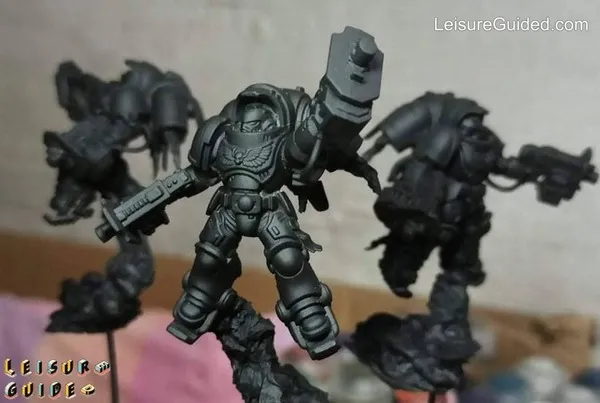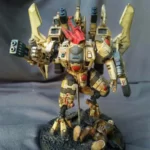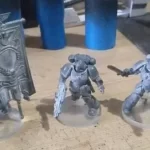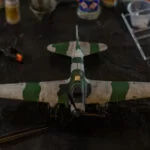Always Prime your Miniatures And Models (Here’s All About It)

There’s so much involved in doing a proper paint job. Of them all, priming is the most essential.
The general knowledge miniature painters have of primer is that they help the paint stick. But, it’s much more than this.


the Secret to Flawless Miniatures and Models: The Crucial Step You Can’t Miss
A primer is a preparatory coat when painting miniatures that help the paint stick. They look quite similar to paints but are not literarily paint. Paints are made up of resin pigments, but primers are actually resins. So, they often work better as a base coat before adding a topcoat of paint.
If you’ve ever painted a wall with paint, you know how well they adhere to your home’s surface and how easily they chip off with time.
Plastic and metal miniatures often have smooth surfaces like walls, even slicker. So, they behave the same way when painted, especially with the chipping features. Fortunately, priming your minis helps you avoid this, giving your paints a sealable and stable platform to adhere to.
can you avoid priming your miniature?
Primer is necessary, especially if you plan on actually handling your miniatures.
However, if you buy models like the WizKids Nolzur’s Miniatures, you will find that they often come pre-primed. So, you won’t have to prime them again, except if you want to.
You can also avoid priming your miniature if it is reaper bone. However, I still prefer to prime them since it makes the paint stick better.
priming vs. base coating
Paints have some level of reflectiveness, especially under light. Most people often choose to use base coating as a substitute for primer. But, the truth is that acrylic paints are transparent. So, if you use the base color, it will have a shading effect on the overall colors. Primers will make the paint easy to blend well.
One Layer of Primer Is Not Enough
Depending on how viscous the paint is, you want to consider two to three thin coats. Then, allow it to cure fully overnight before painting the miniature.
Two types of primers for miniature
There are two basic types of primers for miniature, oil-based and water-based primers*.
As the name suggests, oil-based primers often work better for oil-based or alcohol-based enamel paints and on metal surfaces.
However, water-based primers will work best on water-based acrylic paints. While they may be water-based, they sit well on all materials, whether plastic, resin, or metal.
6 Main Reasons to prime miniatures:
Most miniature painters won’t always consider priming an essential step since it only prolongs the time spent painting their models. However, priming does have its perks. Some of the best reasons to prime miniatures are:
- Priming provides a uniform surface for your paint to stick to your mini better
In simple words, primer binds really well to the model, and paint binds well to the primer. When applied to your miniature, it will create a rough texture (rougher than smooth plastic or metal) for the paint to adhere to so it doesn’t chip easily after hard use.
- Priming helps paint stick, so you will need fewer coats
Acrylic is slightly translucent. Primers act like paints but are not paints. However, they do have the color advantage of paints.
So, if you apply paint on your miniatures without any primed base, the plastic color will be visible through the paint, and you may need multiple coats to get decent coverage.
- Priming helps the paint look better
It also provides an undercoat that will influence the paint colors. How? Most paints, no matter how highly pigmented they are, won’t cover well and leave your model looking poor-quality. Plus, your model may have uneven textures that won’t look good after painting.
Priming gives your model a blendable undertone color, so your paint covers well and looks good. It also evens out uneven textures on the model for a better and more realistic appearance.
- Priming prevents the paint from flaking
Without priming the mode, what happens with paint over bare plastic or metal is that it forms a shell. Acrylic paints are literally watered-down, colored liquid plastic. When the liquid plastic sets, it forms a shell around the model. Not too different from buying a cake with chocolate frosting.
So, if you drop the model, like the chocolate cake, it could crack and flake off in big chunks- since the paint has nothing to adhere to. Priming prevents this from happening.
- Priming will make the painting job easier
Most models come with bumpy surface textures right out of the box. This can make painting over details a chore. Priming makes it easy to paint over these bumps in smooth thin coats.
- Using a colored primer can speed up your painting
If most of the model is going to be one color, colored primers will help speed up your painting. Colored primers feel like painting your model like you would with a hobby paint. It means you won’t have to worry about coverage with your chosen color.
Should you prime any type of miniature?
Pretty much every miniature kit, whether made with plastic, resin, or metal material should be primed.
The simple reason is that paint sticks to the rough texture of the primer much better than the smooth surface of your models.
My Way of Priming Miniatures
Priming may seem simple, but it is more complex than you might think.
The first step starts with getting a decent primer, whether a brush, spray, or airbrush primer. Then, ensure that the humidity in your workspace is not over 75 to 80 degrees. Also, make sure to prime in a well-ventilated interior. You don’t want dust to inhale the fumes from the primer.
After this, thoroughly wash and clean the model to remove the mold release agent that may stop the primer from adhering well to the plastic. It may take a while to prime the miniatures, especially if you are painting armies. So, it is best to do one mini at a time and keep the others away from your spraying area to avoid overspray.
Primers dry very quickly, so quickly, in fact, that if you use primers in a rattle can or an airbrush, the particles from the spray can dry before even hitting a surface. You actually want to spray it closer than you would for regular spray paint, at 6 to 12 inches away. Then again, the distance will vary slightly depending on the humidity around your workspace. With a paintbrush, prime in swift, sweeping motions.
Do one side at a time with thin coats. You will want to do around three to four thin coats. Then, allow it to dry for 30 minutes before adding the base coat.
so yes, You Should prime your miniatures
How necessary is it to use a primer before painting your mini? Critical.
Priming your miniature is 100% required as it makes a huge difference, from how easy your painting project will be to how well the paint sticks to the miniature’s surface, the results you get, and the paint’s durability. So, whether you own a resin, plastic, or metal miniature, prime them before painting.





